The Town That
Went To The Moon
There’s a town in Western Ohio with a claim to fame
no place on earth can match:
Hometown to the first human to set foot on the moon.
by Rick Jackson
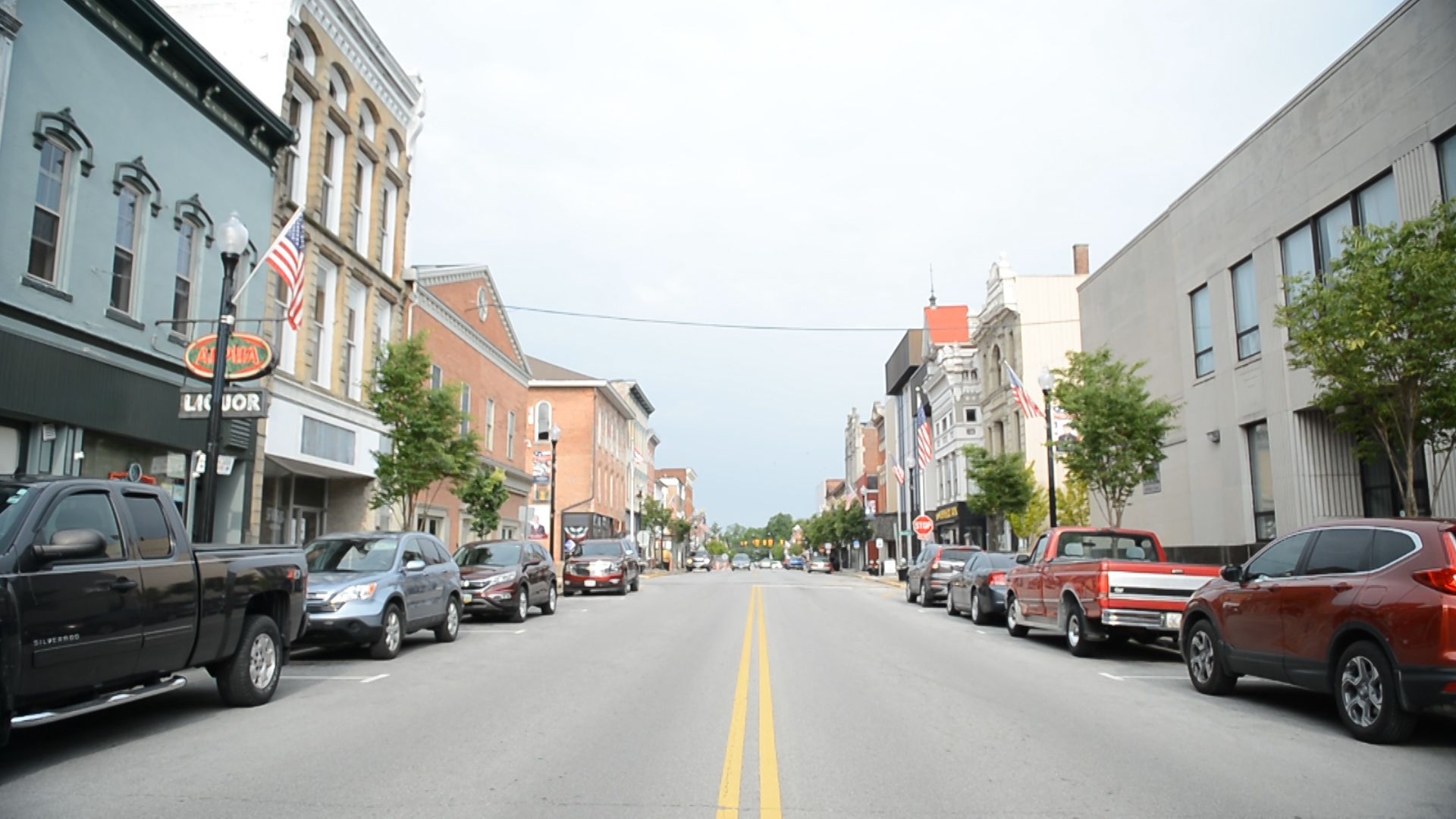
“… 3 – 2 – 1 – 0, all engine running ... Liftoff on Apollo 11.”

So began Neil Armstrong’s grand adventure. His was the stoic face of a goal – to land an American on the moon within 10 years – enunciated by President John F. Kennedy. A goal into which the United States ultimately invested $20 billion ($139.5 billion today – a markup of 597.8 percent!) and the efforts of nearly half a million people.
Approaching the 50th anniversary of Apollo 11’s epic mission, we traveled to the Auglaize County seat to learn more of Armstrong’s roots through the prism of the town that nurtured him and rocketed to fame alongside him.
ideastream’s in-depth local reporting is made possible by donations from supporters like you.
Join us as a Member now.
ideastream.org/donate

“Our Man From Wapakoneta”
Wapakoneta’s identity changed forever in the tumultuous summer of 1969, when native son Neil Alden Armstrong took his "one small step" from the lunar module Eagle onto the surface of the moon. The self-effacing test pilot entered the history books and Wapakoneta assumed its own special place in the annals of the space race - a spot it guards zealously to this day.
From the back bedroom of the house at the corner of Buchanan and West Benton streets in Wapakoneta, Neil the boy probably first pondered the moon, a quarter-century before Neil the man touched its surface.
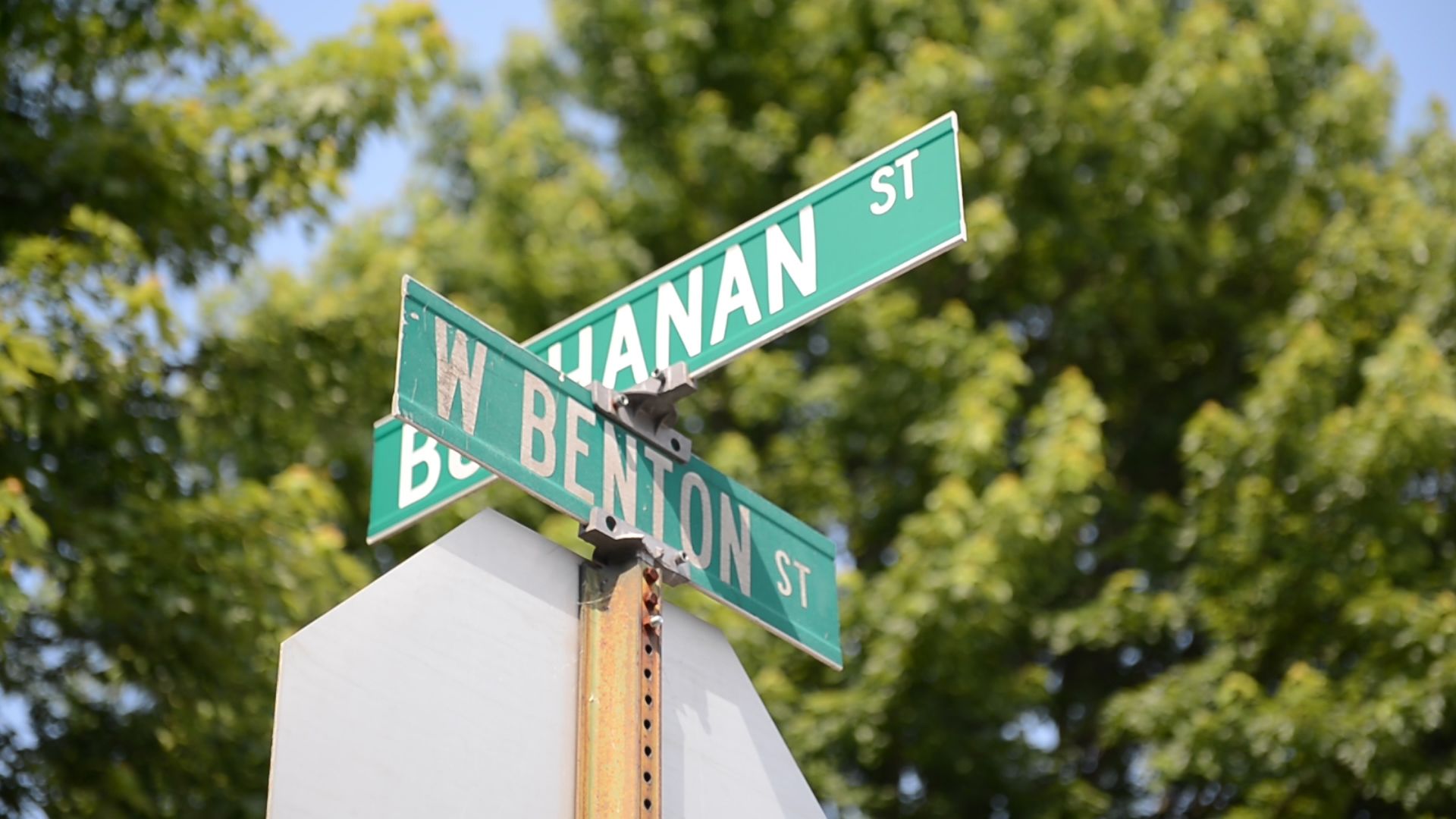
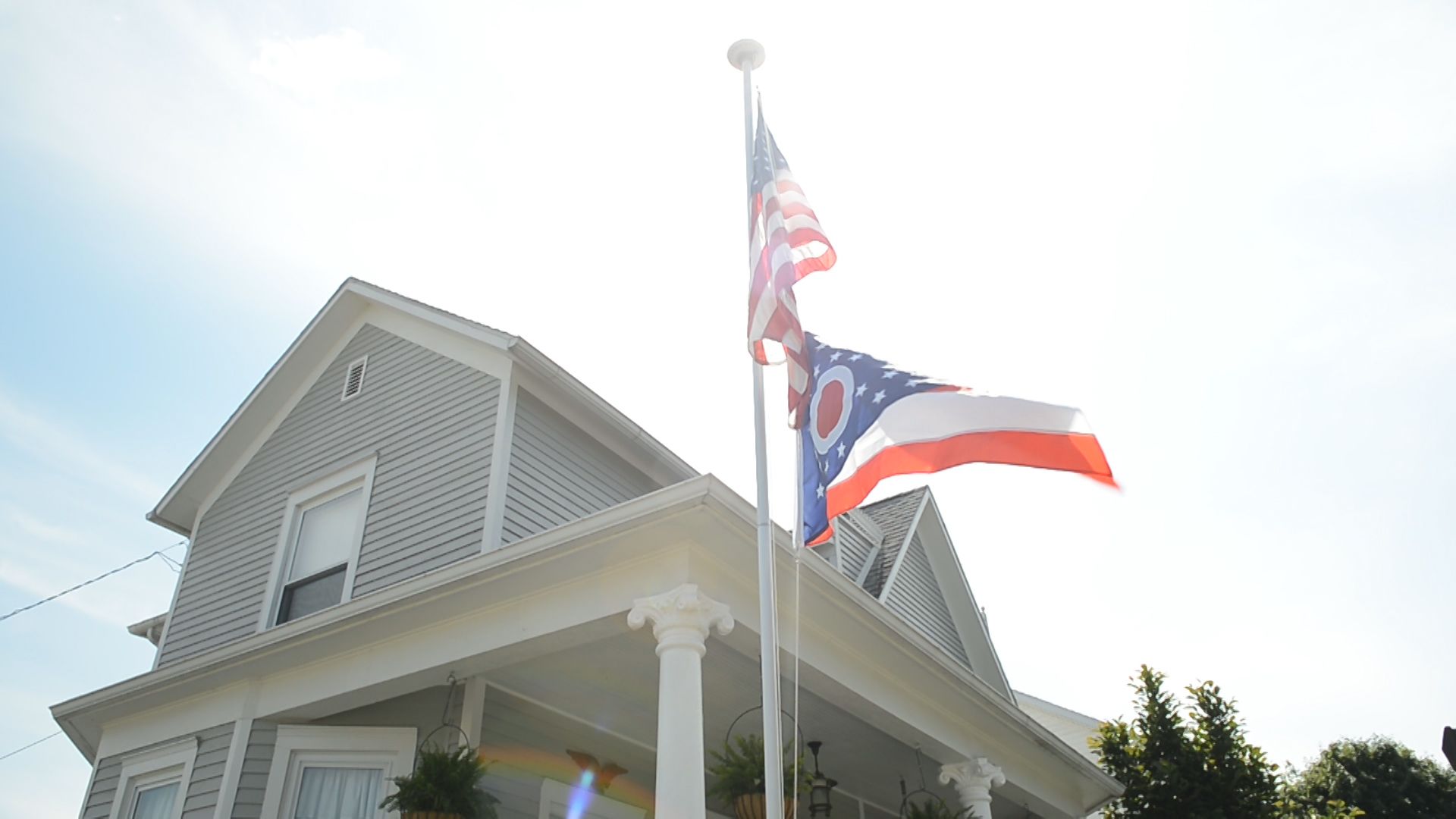
“He was an extraordinary individual,” remembered Armstrong’s longtime friend George Dudley Shuler.
He moved to Wapakoneta about 80 years ago. That’s where he joined a Boy Scout troop and attended high school with Neil Armstrong – a friendship maintained for life.
“He was so completely enthralled, involved with anything that he did. And he thought with such depth,” said Shuler.
Shuler’s connection to the astronaut is perhaps the oldest and deepest in this town, but it seems everybody in Wapak – as locals call it – has an Armstrong story and a fierce pride about him being “theirs.”
“Being the hometown of Neil Armstrong, it’s something we celebrate every year, but for the 50th anniversary, we are celebrating in a very big way,” said Jackie Martell of the Wapakoneta Chamber of Commerce.
Expectations are for about 50,000 people from around the world to pack this town of less than 10,000 residents on July 20.
NASA Television will base one of its four live commemorative broadcasts here. At least five past and present astronauts, several with Ohio connections or roots, will be in town.
There will be reunions of all sorts that date back to 1969 and that summer Sunday when so many gathered around fuzzy black-and-white TV sets.
“I know that at Neil’s parents’ home, there were TV towers up. Mrs. Armstrong talked about people grabbing grass out of their front yard and keeping it as souvenirs. So we had quite the media attention here back in 1969.”
But the commemoration of the moon landing is not just a celebration the town threw together to capitalize on this anniversary.
In many ways, Wapakoneta is a time capsule - a snapshot of a different America - with a main street of small shops, antique stores and eateries, century-old homes and businesses, historic civic structures, a place where freight trains rumble through major intersections several times a day. There's even a 115-year-old movie theater showing just one feature film each day.
It’s a place where the present coexists with a more serene past.
“It’s not an abstract connection we have to Neil Armstrong. We can show you where he was born,” said Rachel Barber, co-chair of the commemoration committee. “We can show you his boyhood home, where he went to school, where he worked after school to earn money for his flight lessons.
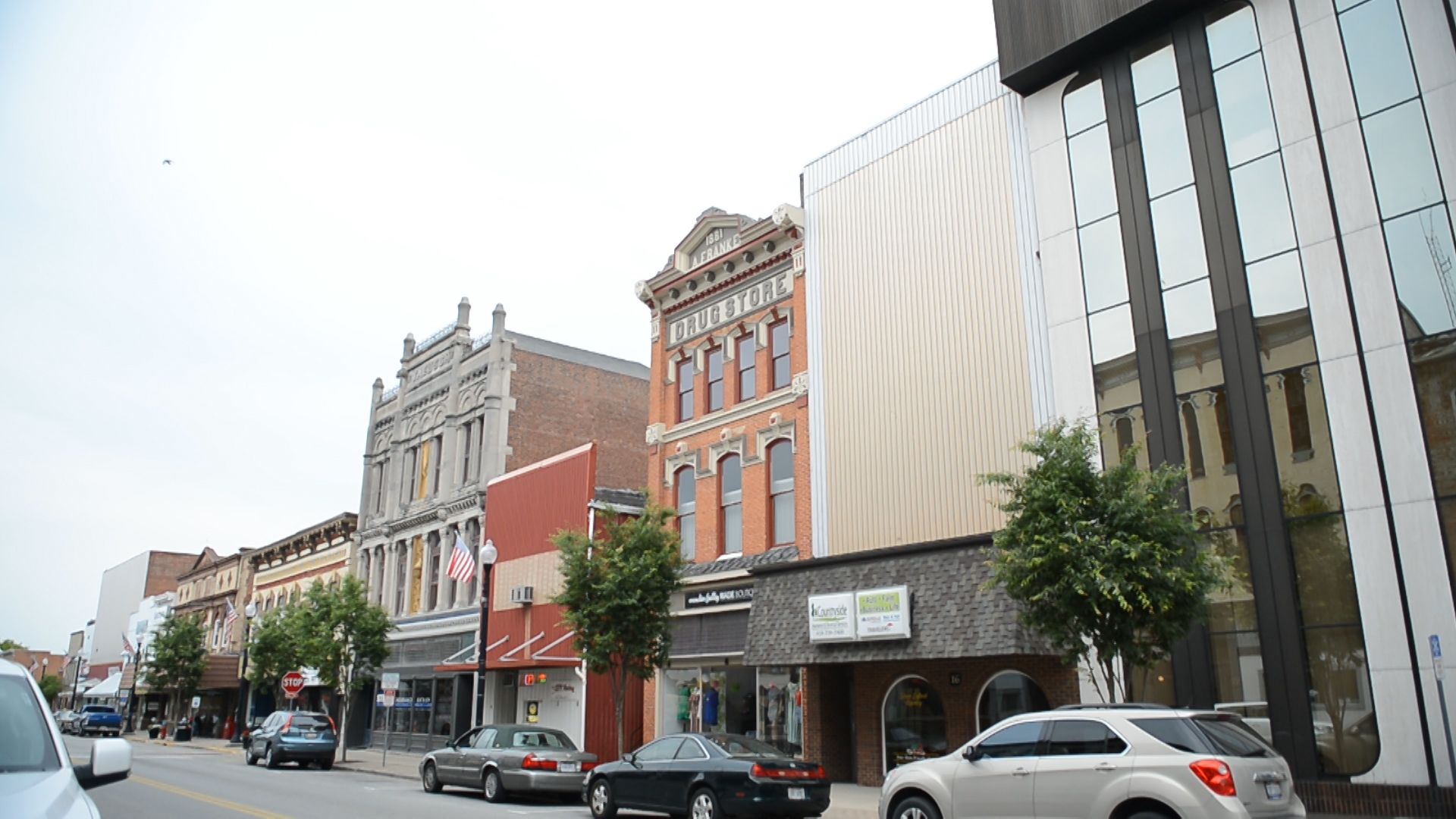
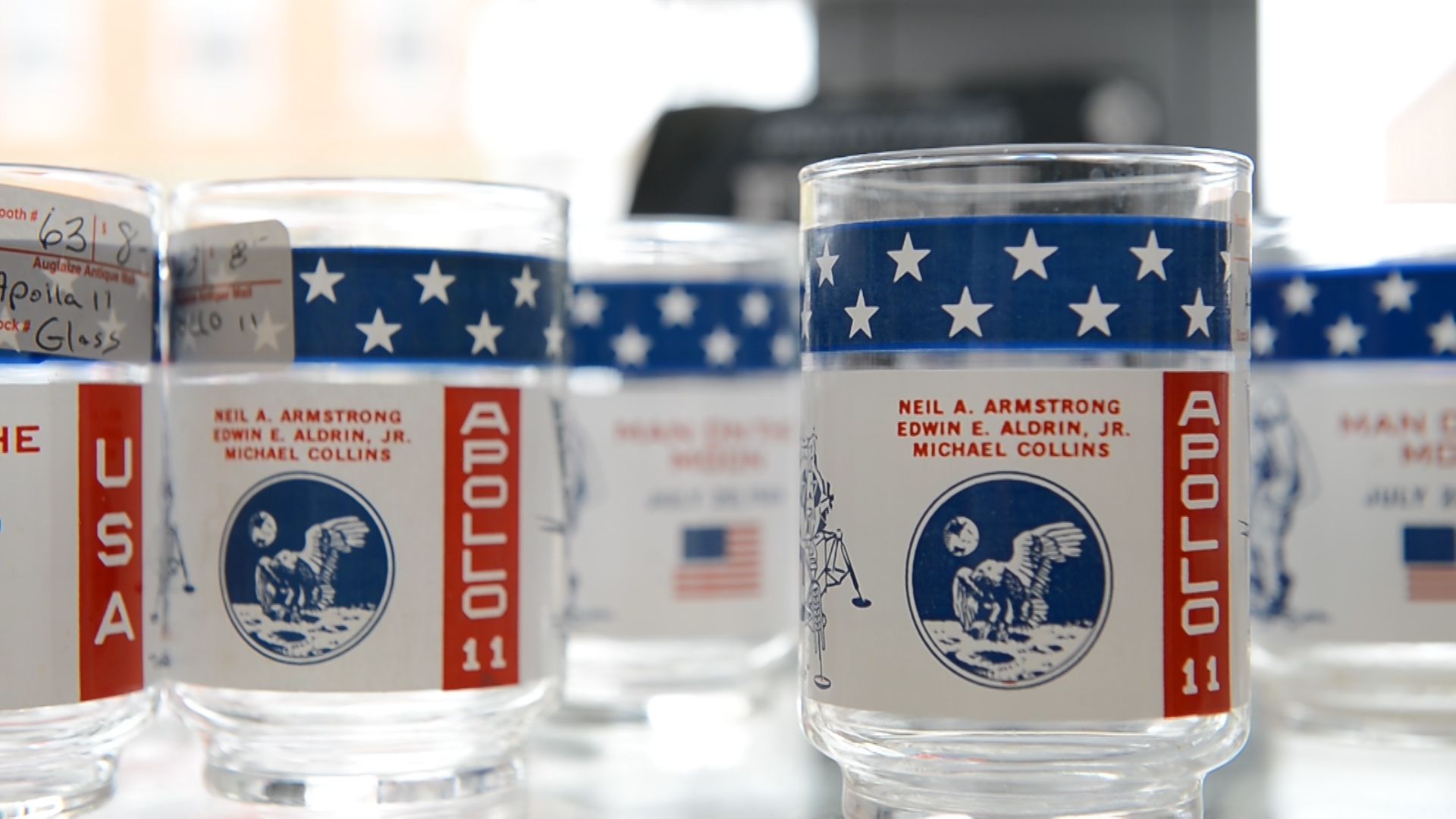
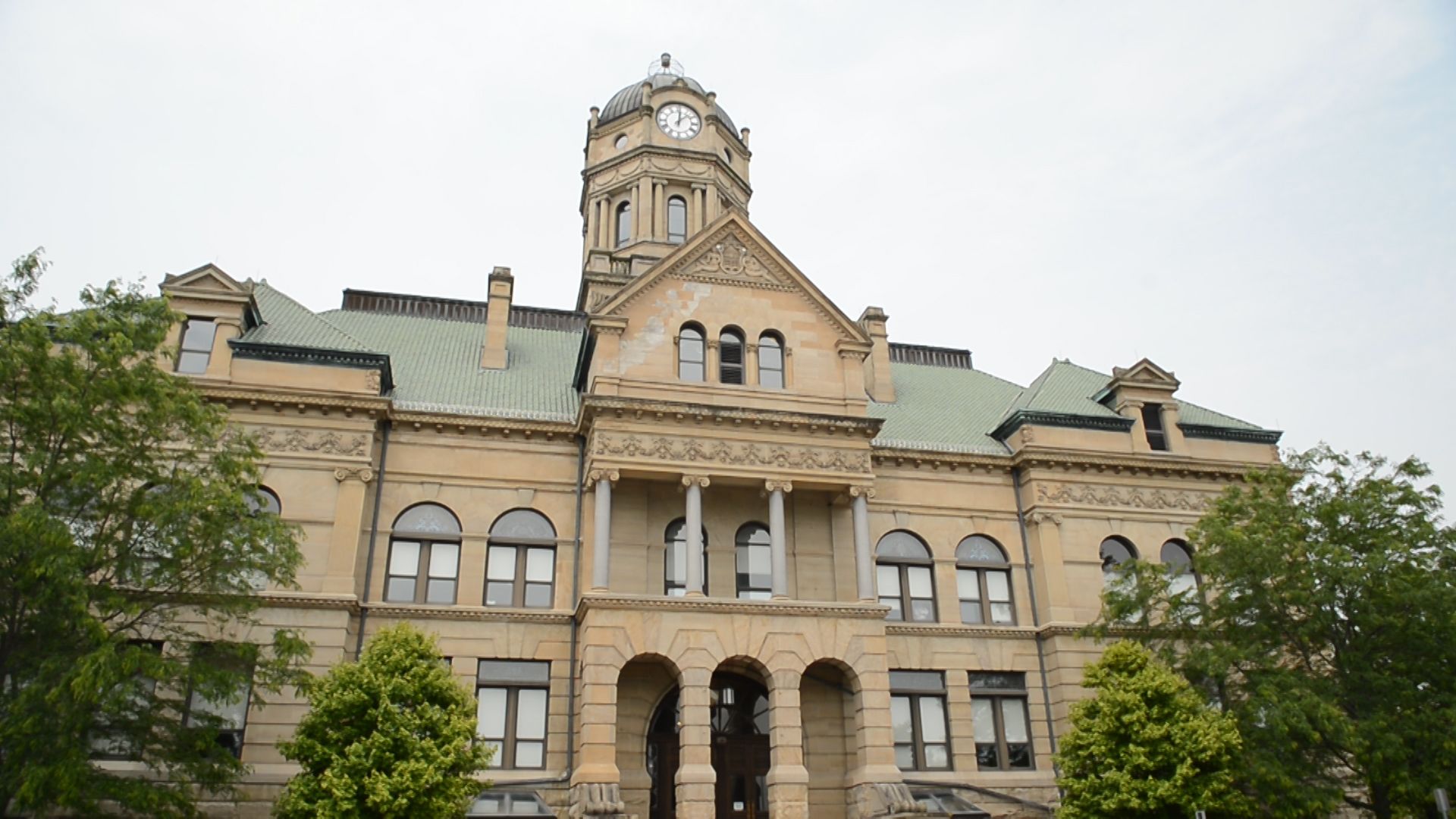
Defying Gravity

Pieces of Armstrong’s past are preserved inside the Neil Armstrong Air and Space Museum, commissioned by then-governor James Rhodes while Armstrong and Buzz Aldrin were still on the lunar surface.
Though it sits on the outskirts of this small town, where travelers on I-75 can catch a glimpse as they drive by, the museum is Wapakoneta’s emotional centerpiece.
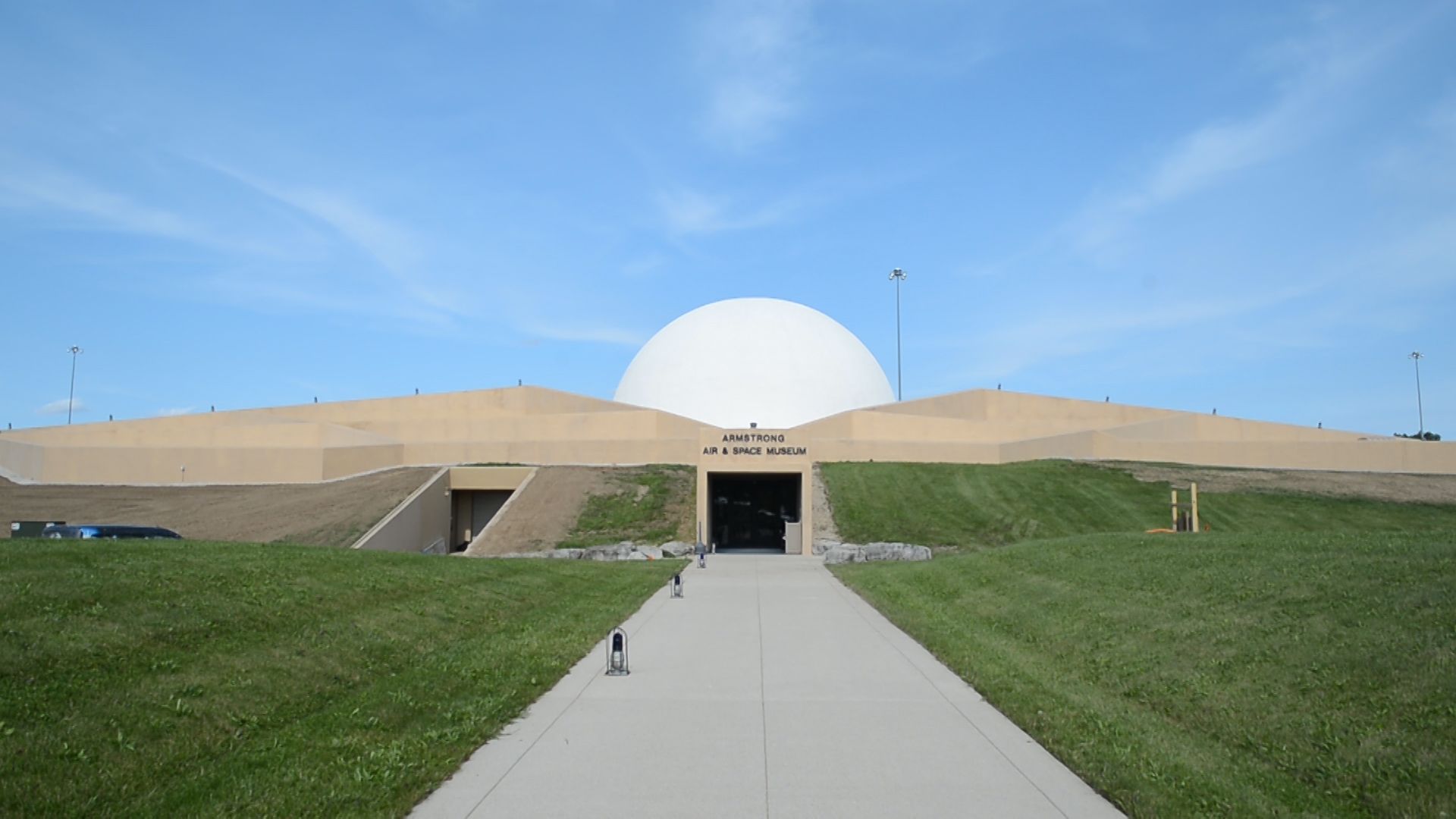
Designed by a Wapakoneta native as part of a national design competition, the Neil Armstrong Air and Space Museum is meant to resemble a futuristic moon base. [Jean-Marie Papoi / ideastream]
Designed by a Wapakoneta native as part of a national design competition, the Neil Armstrong Air and Space Museum is meant to resemble a futuristic moon base. [Jean-Marie Papoi / ideastream]
Funding it was a challenge from the get-go, literally: Rhodes told the people here that if they raised $500,000, the State of Ohio would match it. They reached his goal and then some. The museum opened just three years later.
“It was built in honor of Neil Armstrong and all Ohioans who have attempted to defy gravity.”
“The point was that it was just Neil going to the moon, but it was all Ohioans and actually all Americans who helped put the first man on the moon,” said Zwez.
They’ve memorialized the two-seat, single engine plane from Armstrong’s flight lessons: an Aeronca Champion, affectionately known to pilots as the Champ. It was the first of more than 200 aircraft types Armstrong piloted over his career.
Outside sits a NASA experimental jet of which only four were made.
The museum’s artifacts range from high school yearbooks replete with photos of Armstrong to newspapers from around the globe reporting the historic July 20, 1969, landing.
From Armstrong’s own spacesuits to the actual Gemini VIII spacecraft Command Pilot Armstrong rescued after a malfunction nearly killed him and Pilot David Scott in 1966 as they attempted the first docking of two spacecraft in orbit.
But even though the Gemini VIII capsule actually went to space and came back with Armstrong at the helm, the museum’s most prized possession is probably a rock.
A rock Armstrong himself brought home from the moon.
Armstrong visited the museum maybe a dozen times, according to Zwez, and he believes one of the astronaut’s concerns was that people would think that the museum belonged to him. A plaque outside makes it clear: Armstrong donated many of the items inside, but this museum belongs to Wapakoneta.
“That goes back to the whole idea of the moon landing and when he talked about going to the moon, it was just not him up there. There were so many other people involved,” said Zwez.
“That was the thing that I was impressed with when I would talk with him about it, was the pride in doing the job. He was not alone. There was an awful lot of other people who were involved to put him on the moon.”
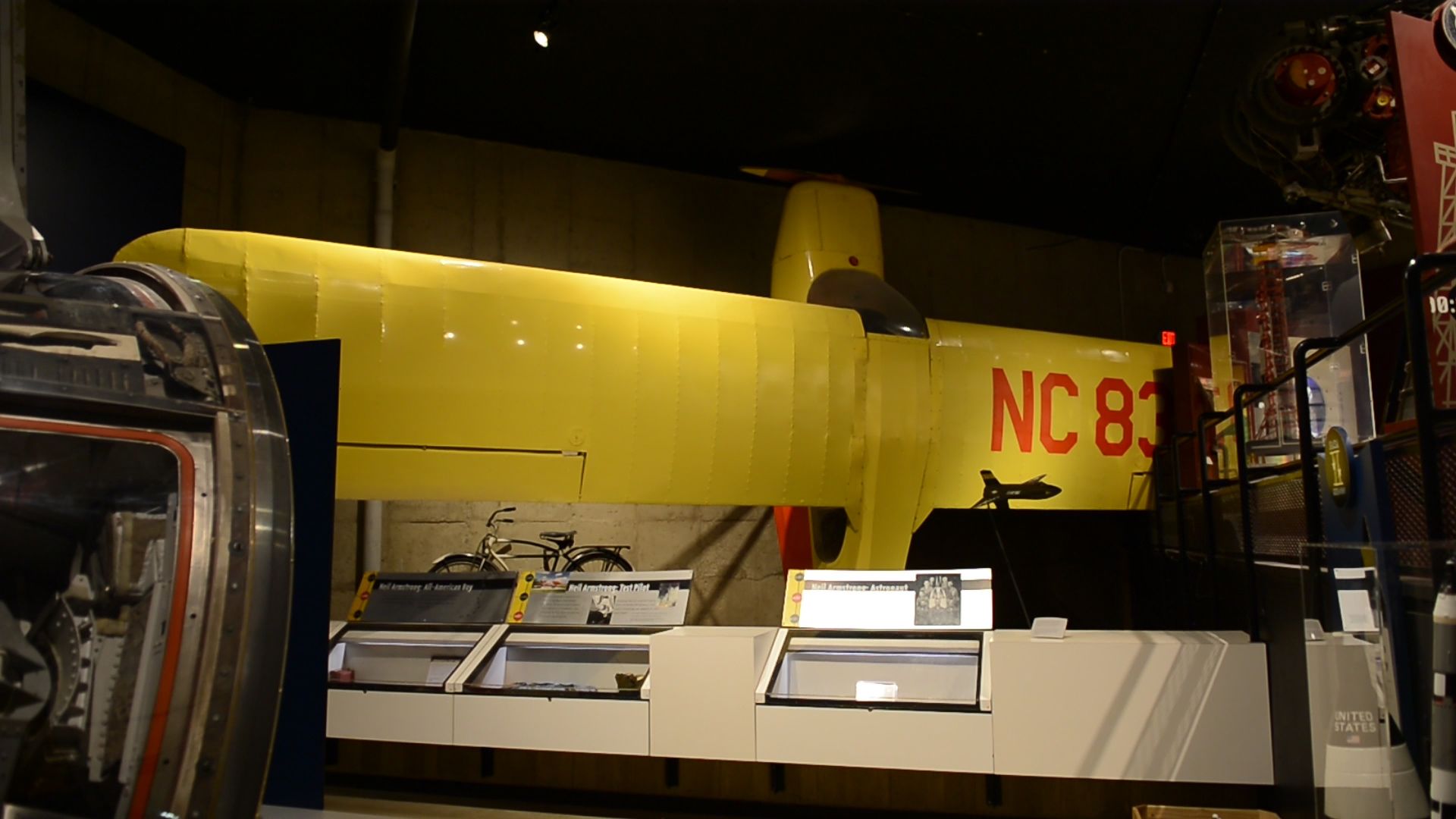
Armstrong learned to fly in an Aeronca Champion - a two-seat, single engine plane. He earned his pilot's license on his 16th birthday. [Jean-Marie Papoi / ideastream]
Armstrong learned to fly in an Aeronca Champion - a two-seat, single engine plane. He earned his pilot's license on his 16th birthday. [Jean-Marie Papoi / ideastream]
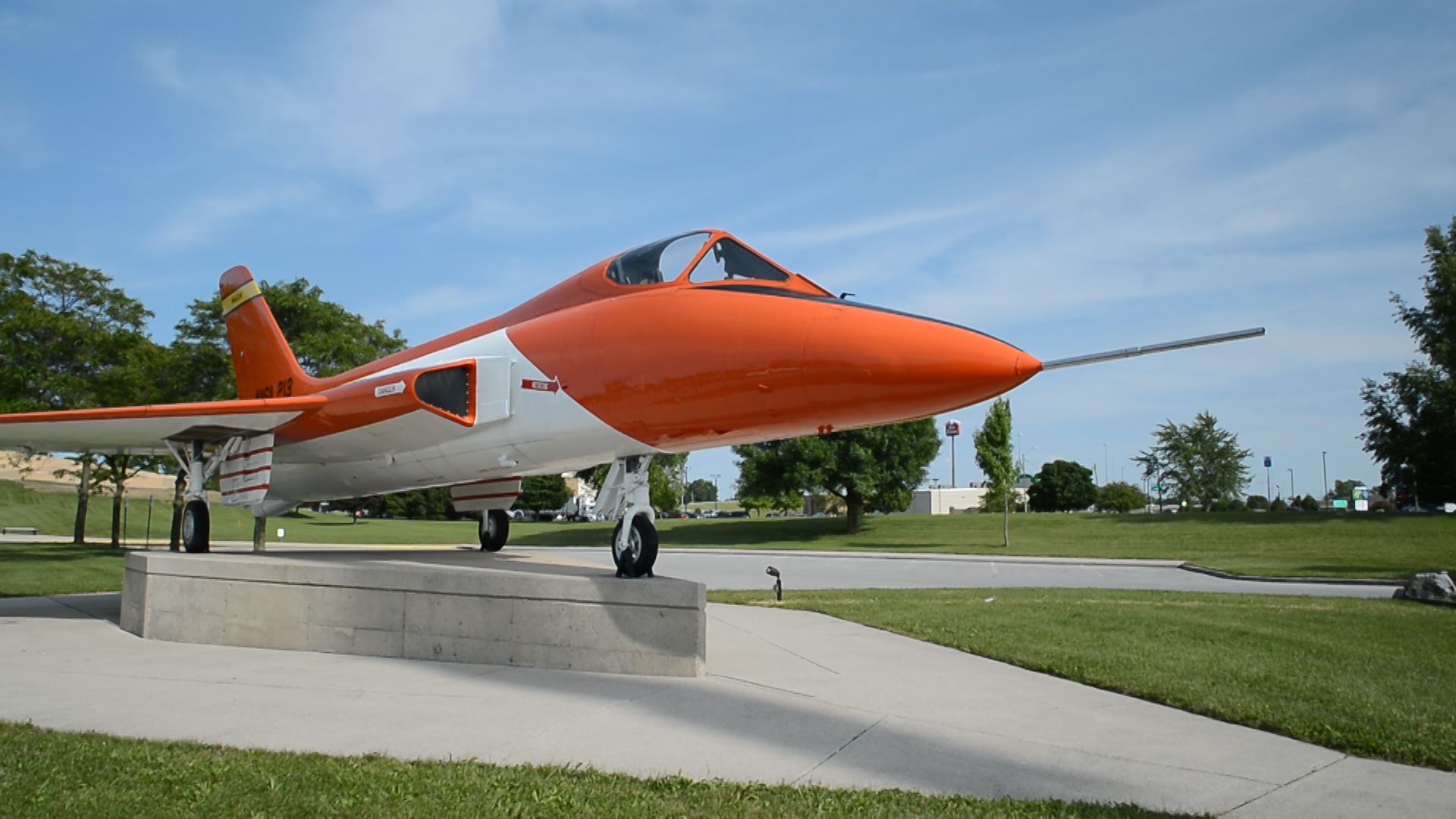
The F5D Skylancer was an experimental NASA jet. It sits outside the Neil Armstrong Air and Space Museum. [Jean-Marie Papoi / ideastream]
The F5D Skylancer was an experimental NASA jet. It sits outside the Neil Armstrong Air and Space Museum. [Jean-Marie Papoi / ideastream]
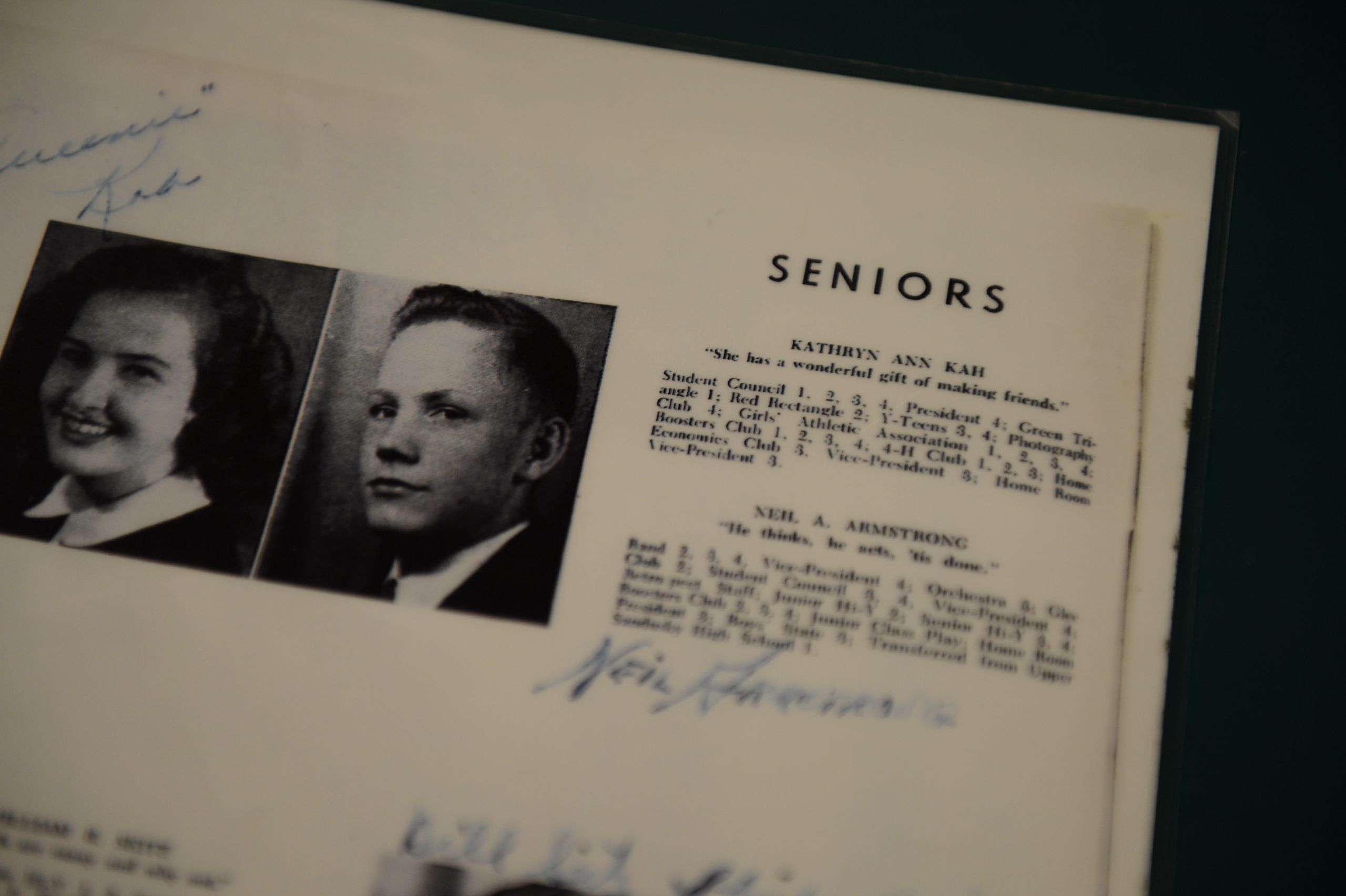
Armstrong graduated from Bloom High School in 1947 and went to college at Purdue University. [Jean-Marie Papoi / ideastream]
Armstrong graduated from Bloom High School in 1947 and went to college at Purdue University. [Jean-Marie Papoi / ideastream]
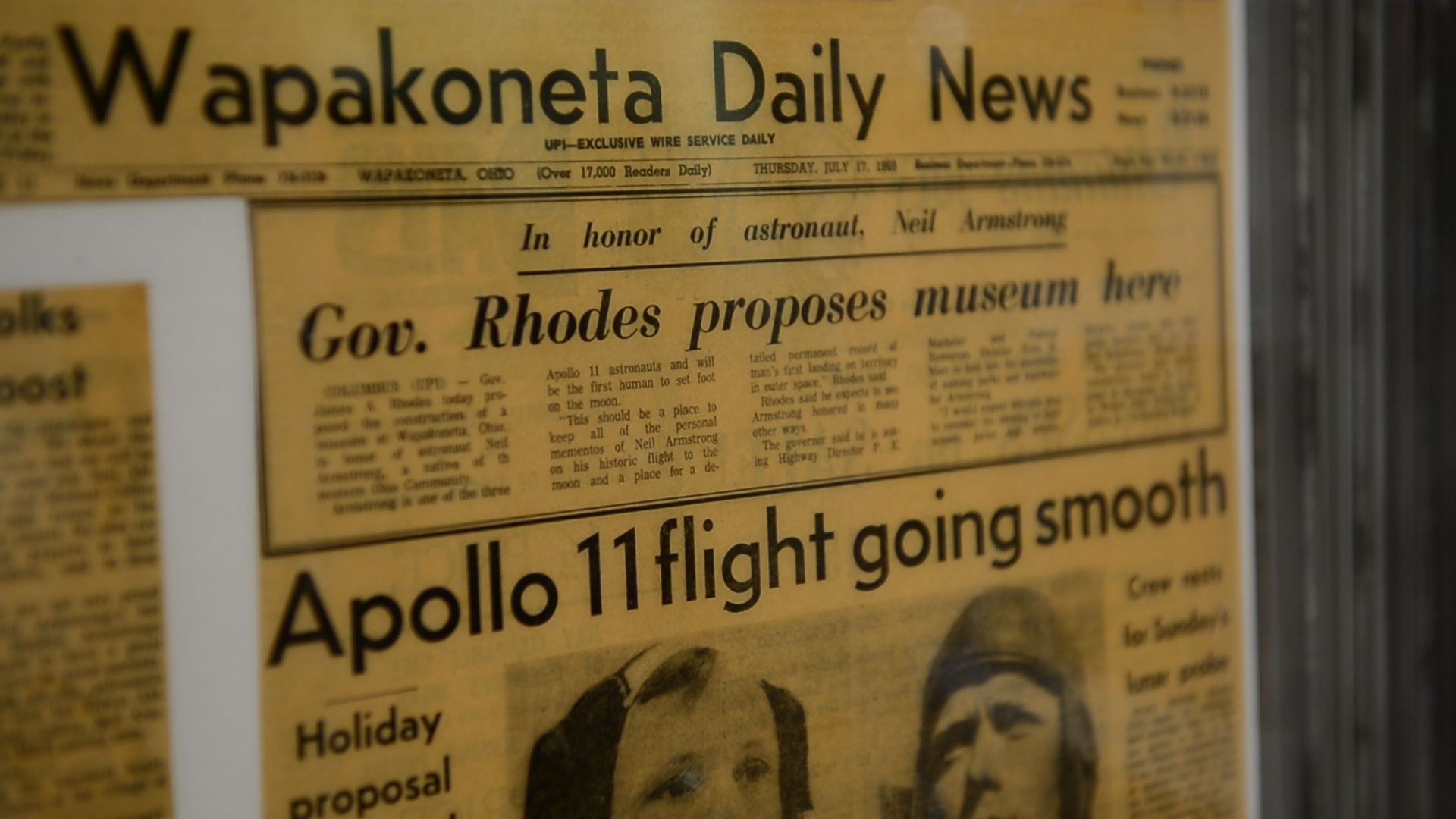
Wapakoneta Daily News front page on display at the Neil Armstrong Air and Space Museum. [Jean-Marie Papoi / ideastream]
Wapakoneta Daily News front page on display at the Neil Armstrong Air and Space Museum. [Jean-Marie Papoi / ideastream]
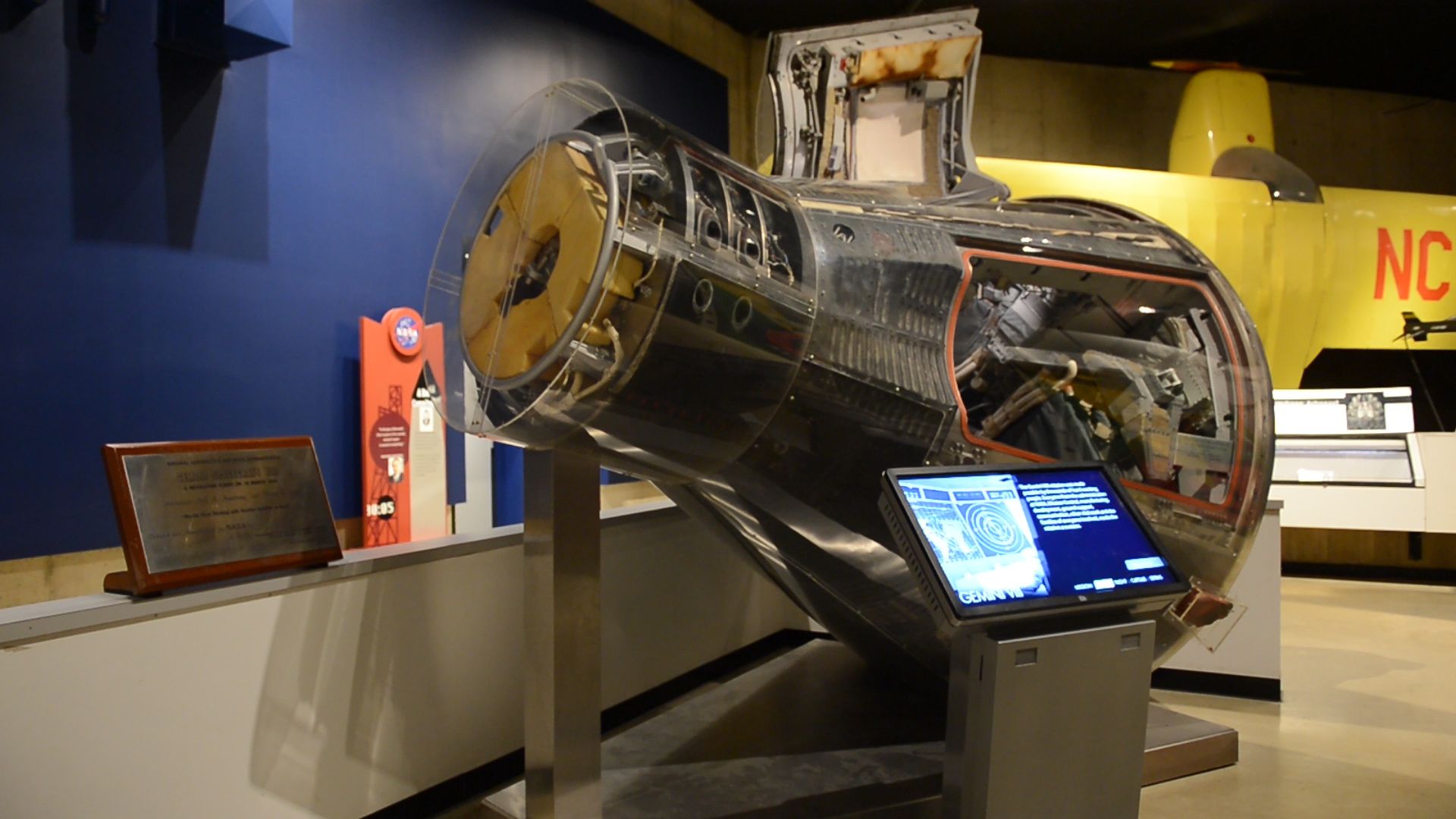
Armstrong and pilot David Scott were the first to successfully link two spacecraft, the Gemini VIII and the Agena, while in orbit. [Jean-Marie Papoi / ideastream]
Armstrong and pilot David Scott were the first to successfully link two spacecraft, the Gemini VIII and the Agena, while in orbit. [Jean-Marie Papoi / ideastream]
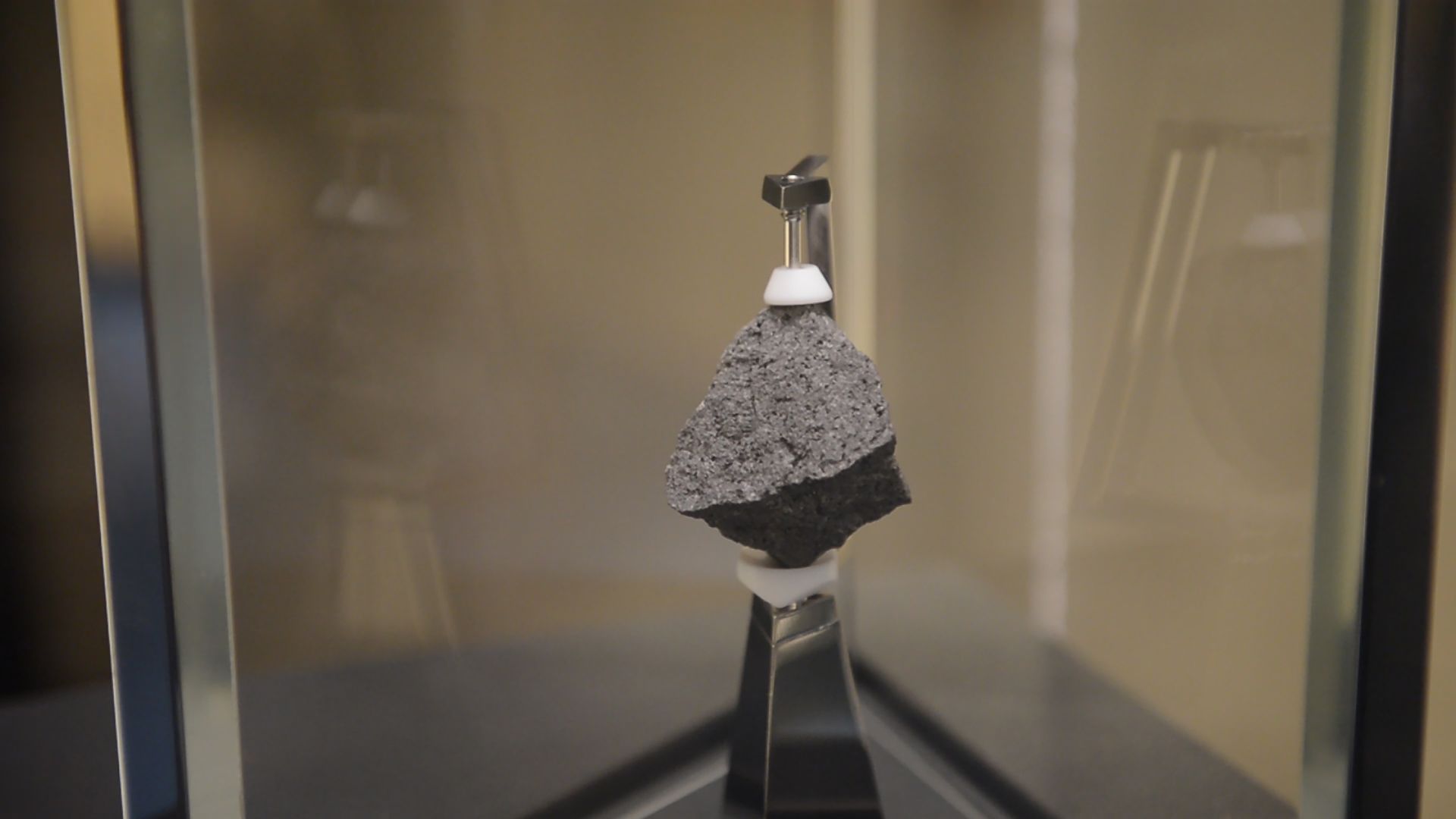
A rock about the size of a walnut from the moon's crust estimated at over four billion years old, brought back to earth by astronauts Neil Armstrong and Buzz Aldrin. [Jean-Marie Papoi / ideastream]
A rock about the size of a walnut from the moon's crust estimated at over four billion years old, brought back to earth by astronauts Neil Armstrong and Buzz Aldrin. [Jean-Marie Papoi / ideastream]
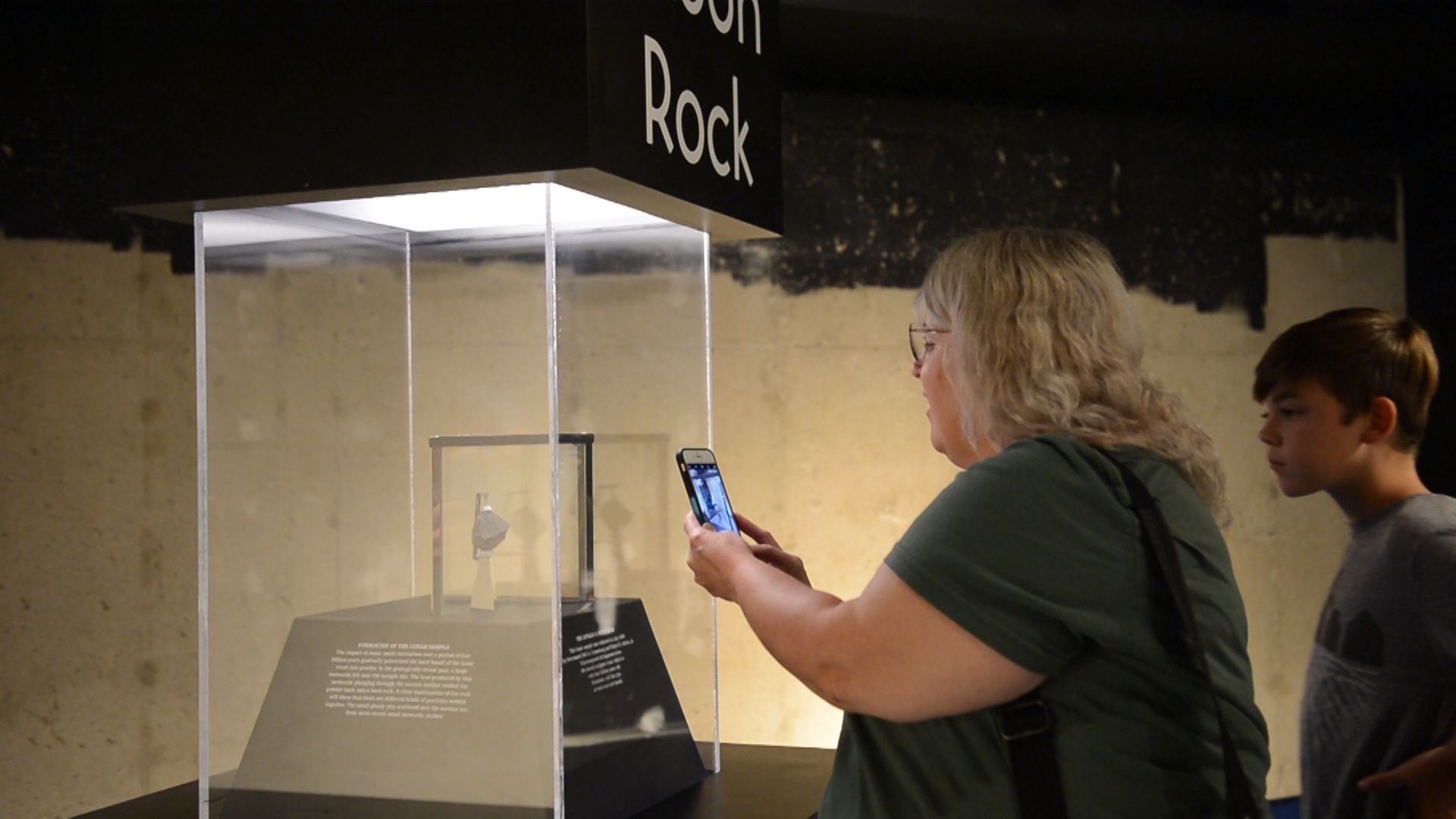
"I didn't realize that he flew before he drove," said LaQuita Brewster who stopped into the museum on her way driving home to Philadelphia, Tenn. [Jean-Marie Papoi / ideastream]
"I didn't realize that he flew before he drove," said LaQuita Brewster who stopped into the museum on her way driving home to Philadelphia, Tenn. [Jean-Marie Papoi / ideastream]
“Neil Armstrong. He was the astronaut I was fascinated with,” said LaQuita Brewster of Philadelphia, Tenn.
Brewster and her 12-year-old son Dallas are those typical ‘I didn’t know this was here’ visitors who spotted the museum while passing by on the interstate.
It turns out they’re huge spaceflight fans – committed enough to change their plans so they could spend the night in town and see all they could, including a visit to the home where Armstrong was raised - the house at 601 W. Benton called Eagle’s Landing.
Eagle’s Landing
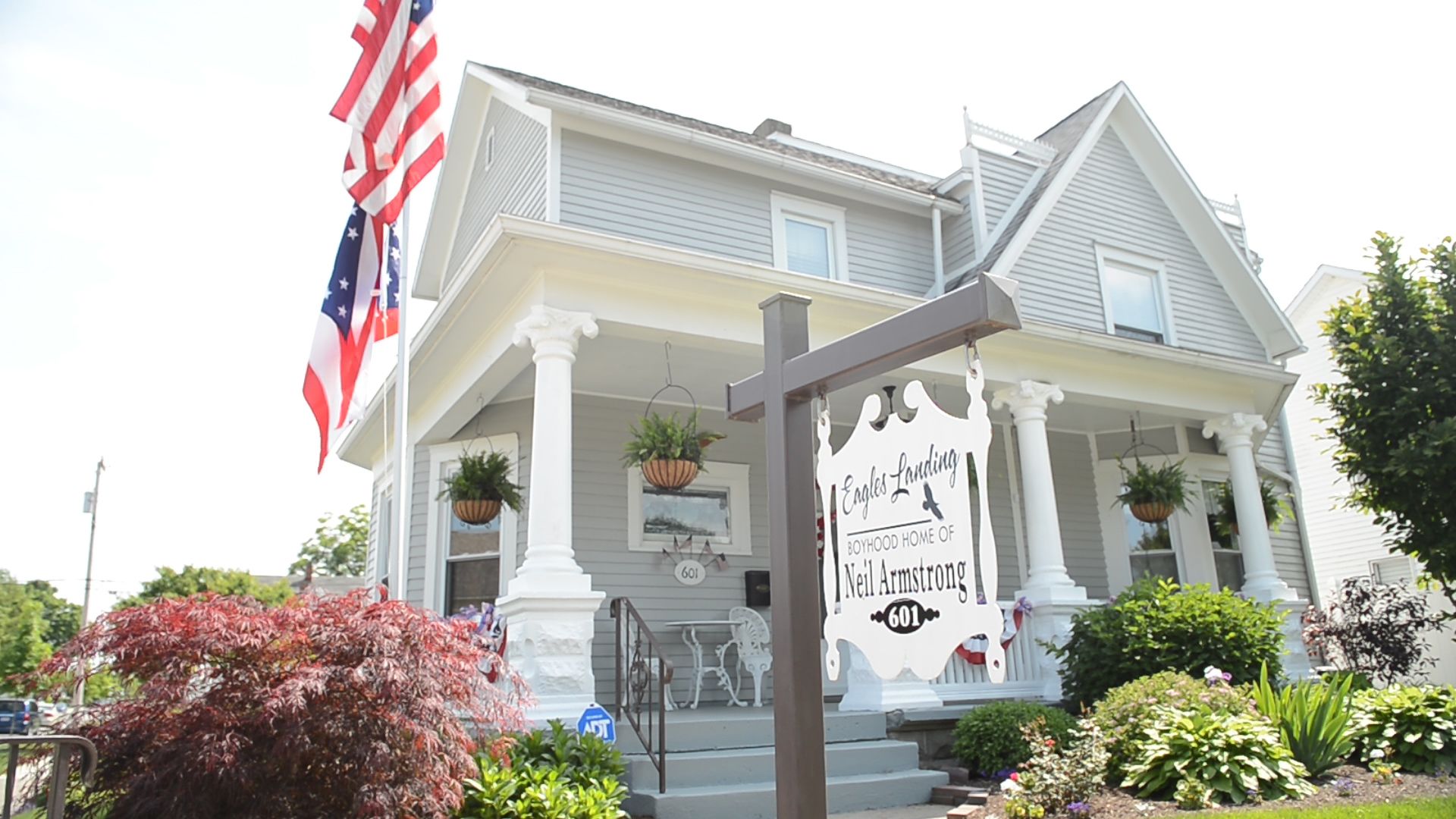
Karen Tullis lives here now.
“Some friends of mine were visiting and we were talking and one of them said, ‘You know, we ought to come up with a name for this house.’ And of course the name Eagle’s Nest came up, and I said absolutely not,” Tullis said. “Then we came up with Eagle’s Landing, and that’s how the house got its name.”
She bought it 30 years ago, without knowing it had been home to Auglaize County’s most famous resident. A former schoolteacher in Wapakoneta and throughout western Ohio, Tullis loved having history at her fingertips. She talks to visitors out front nearly every day, reinforcing the idea of Armstrong as the salt of the earth.
“Some people called him a recluse, some people get upset because he didn’t come back home as much as they felt he should,” she said.
“He didn’t do it for the glory. He did it because this is what he was called to do.”
Like most residents here, Tullis looks forward to helping recreate the parade of the century in Wapak – that day when Armstrong came home.
Parading Through History Again
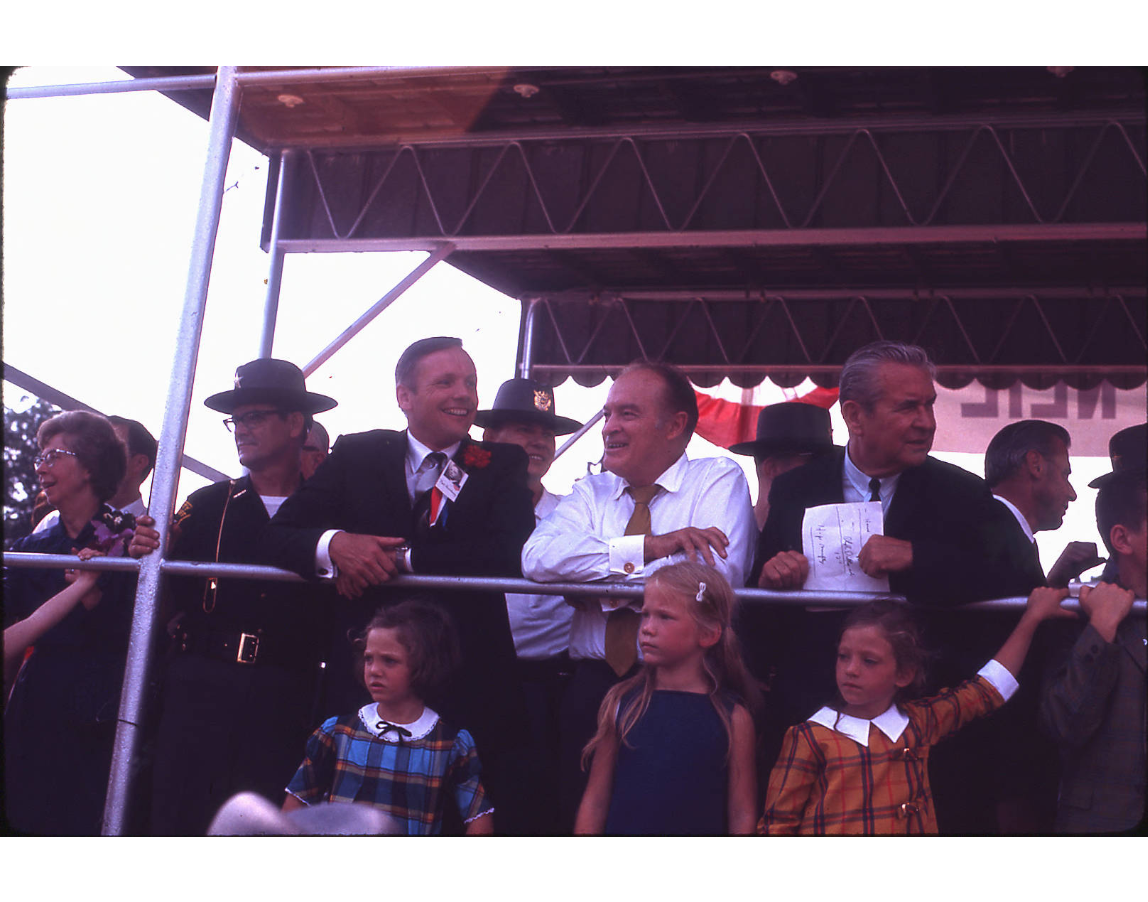
The 1969 parade celebrating Armstrong’s return was Wapakoneta’s gold standard, the parade by which all others are measured. It traveled south down Auglaize Street with Ohioan Bob Hope serving as Grand Marshall, watching alongside Armstrong himself.
The committee putting together the 50th commemoration says its goal is to make this year’s parade every bit as big, and every bit as memorable.
“We have committees that have been working for over two years on this festival and many activities leading up to the anniversary date that we've been offering to the community, and then we'll ramp up to the 10-day celebration which will bring in people from outside of the community to celebrate with us,” said the Wapakoneta Chamber of Commerce’s Jackie Martell.

A commemorative license plate for sale in a Wapakoneta store. [Jean-Marie Papoi / ideastream]
A commemorative license plate for sale in a Wapakoneta store. [Jean-Marie Papoi / ideastream]
It’s a celebration that will be as much about the man and the times as it is about the moon, Barber said.
“That was a goal of our 2019 celebration committee - to bring as many people around the table as we could and reflect as many themes for people to plug into,” said Rachel Barber with the commemoration committee. “I'm not a space geek, so you know, what am I going to be interested in? Maybe the music of the 60s or the movies of the 60s. Other people might be interested in the fashions of the 60s.”
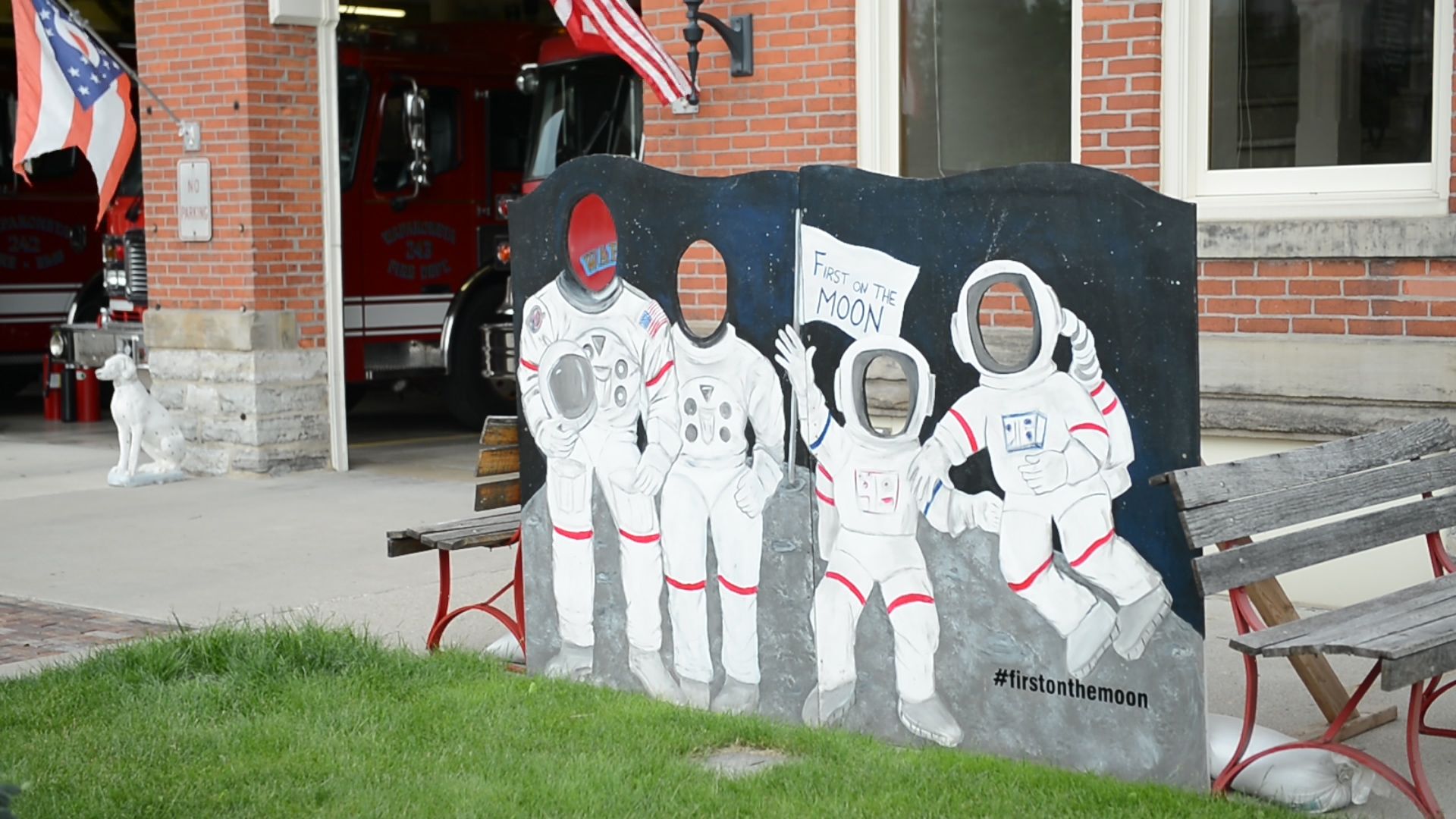
A cut-out outside the Wapakoneta fire department. [Jean-Marie Papoi / ideastream]
A cut-out outside the Wapakoneta fire department. [Jean-Marie Papoi / ideastream]
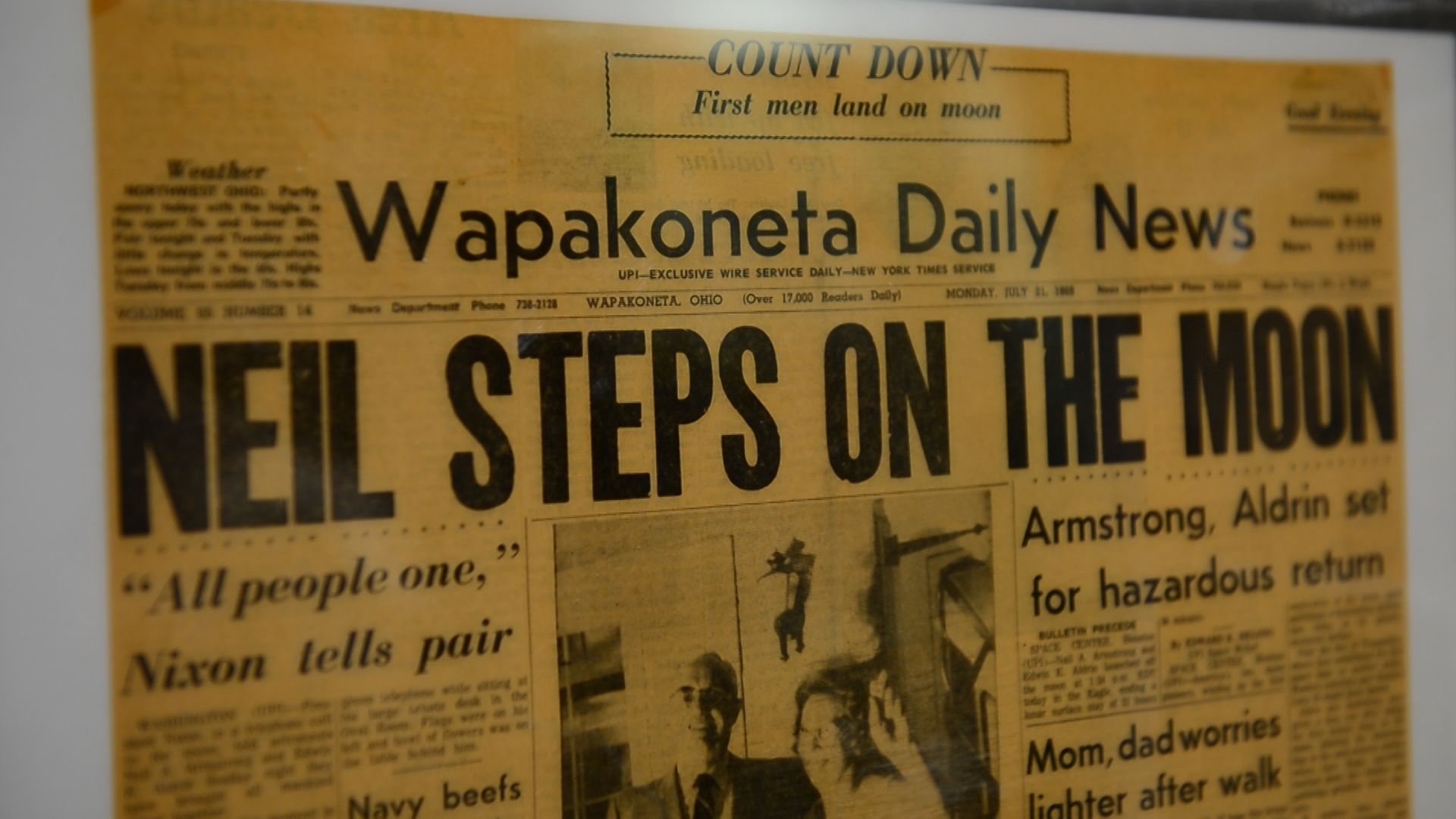
A picture of the front page of the local newspaper, the Wapakoneta Daily News, on the day that native son Neil Armstrong first stepped on the moon. [Neil Armstrong Air and Space Museum]
A picture of the front page of the local newspaper, the Wapakoneta Daily News, on the day that native son Neil Armstrong first stepped on the moon. [Neil Armstrong Air and Space Museum]
This golden anniversary of the moon landing is something of a last big chance for eyewitnesses and friends of Armstrong to reminisce and share their stories with younger generations, those who are the future of spaceflight, said Dante Centuori, current director of the Neil Armstrong Air and Space Museum.
“We’re at the 50th anniversary of the Apollo 11 moon landing, and that 50th anniversary is that pivot point,” Centuori said. “It’s the last big significant anniversary of an event where most of the people who experienced it or participated in it are going to be around.”
As the day nears, the excitement builds – excitement for a man who lived an exciting life, yet shunned the spotlight that came with it – and the memories flood in all over town.
“Fifty years. A man on the moon,” said Louis Erb, another Armstrong childhood friend. “Fifty years ago, you’d never seen anything like that. We said we would put a man on the moon and then we did. And it happened to be our man from Wapakoneta, Ohio. Neil Armstrong.”
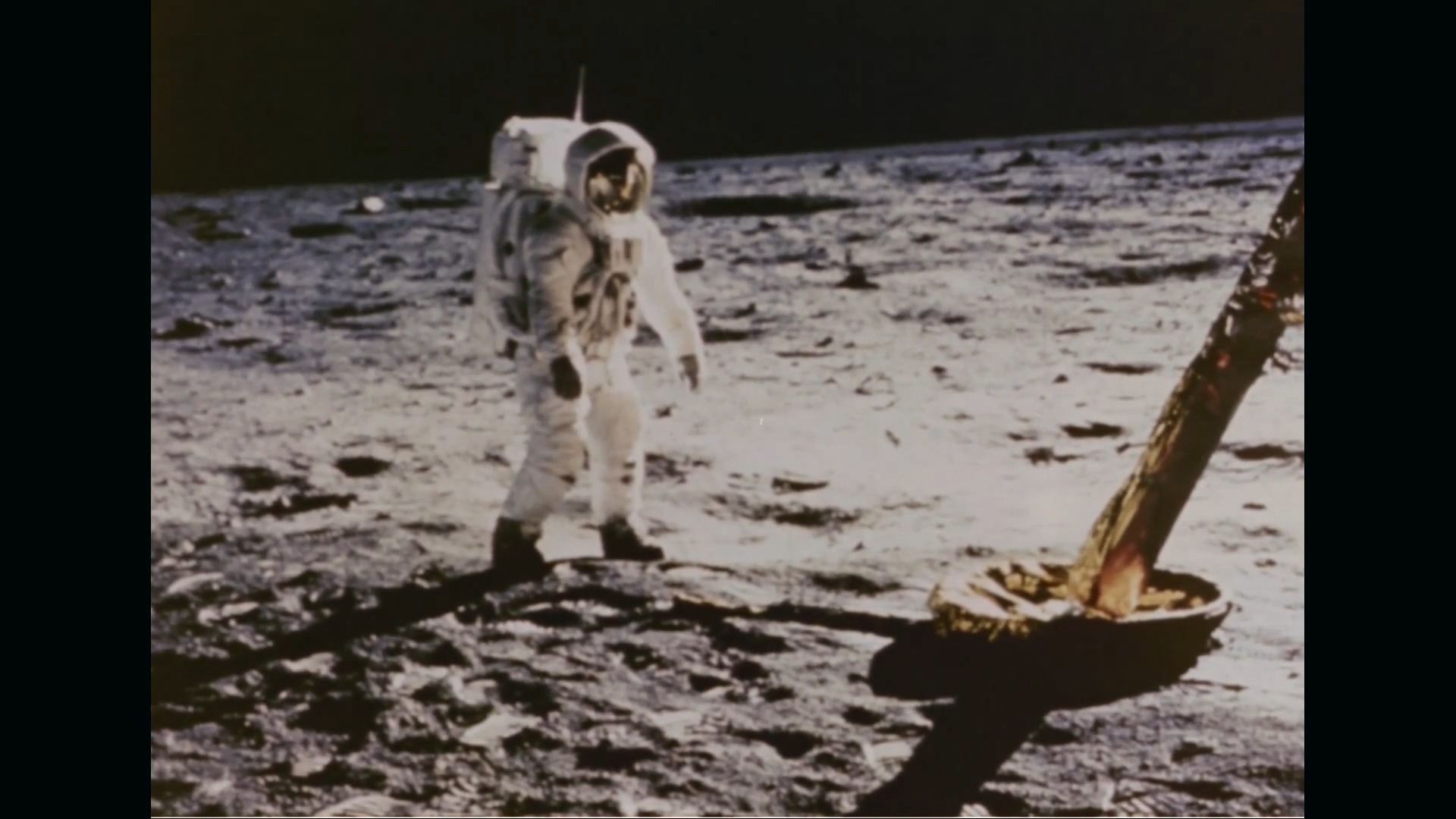
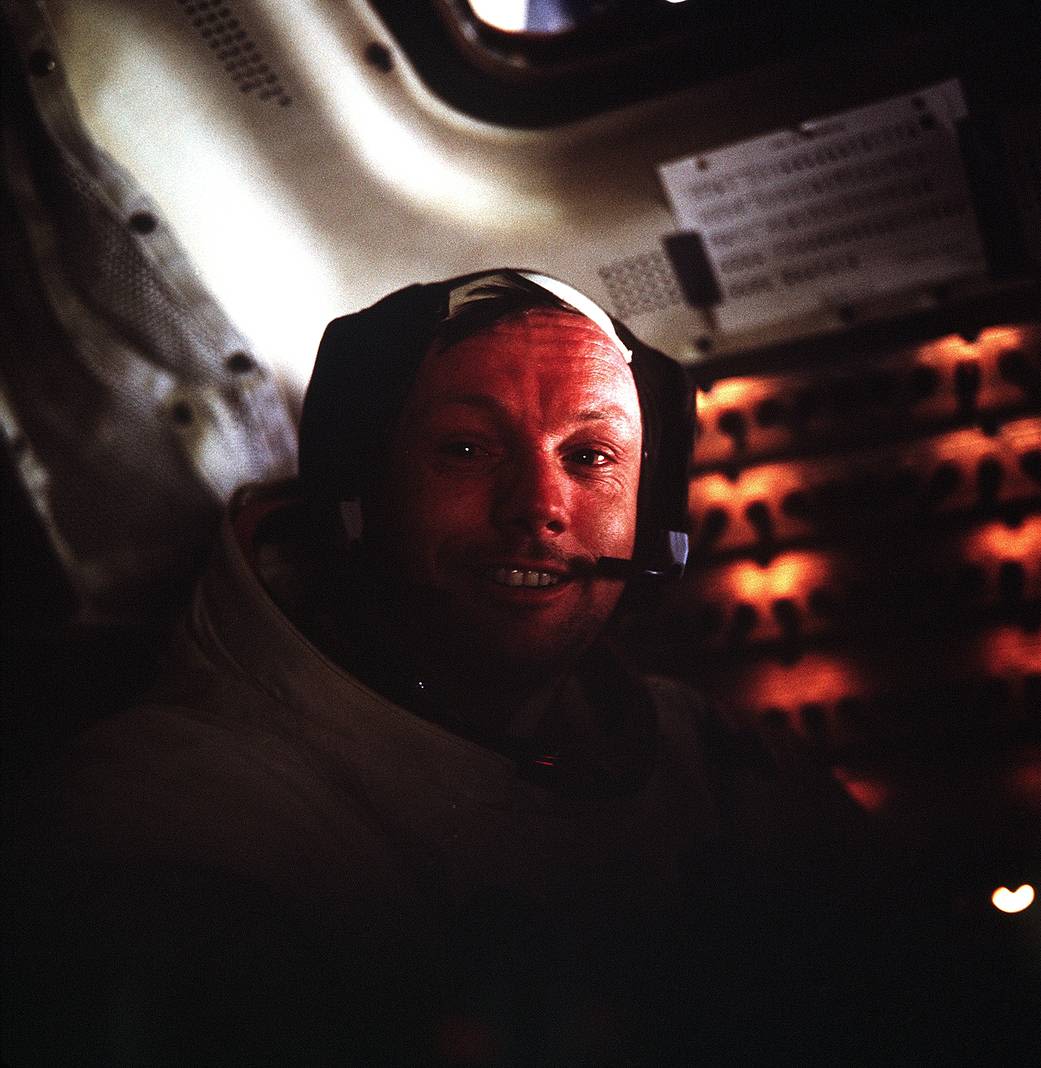
This photograph of Armstrong from the Apollo 11 mission was taken inside the Lunar Module (LM) while the LM rested on the moon's surface. Astronauts Armstrong and Edwin E. Aldrin Jr., lunar module pilot, had already completed their historic spacewalk when this picture was taken. Astronaut Michael Collins, command module pilot, remained with the Command and Service Modules (CSM) in lunar orbit while Armstrong and Aldrin explored the moon's surface. [NASA}
This photograph of Armstrong from the Apollo 11 mission was taken inside the Lunar Module (LM) while the LM rested on the moon's surface. Astronauts Armstrong and Edwin E. Aldrin Jr., lunar module pilot, had already completed their historic spacewalk when this picture was taken. Astronaut Michael Collins, command module pilot, remained with the Command and Service Modules (CSM) in lunar orbit while Armstrong and Aldrin explored the moon's surface. [NASA}


